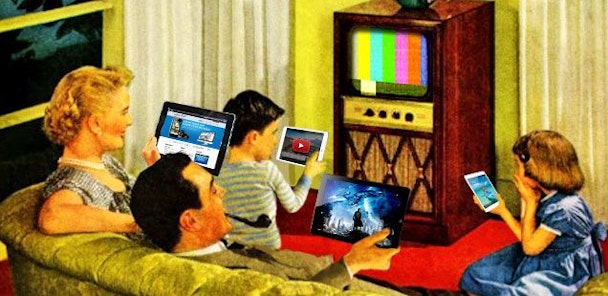Real living, real marketing: Is your media planning fit for today's living room behaviour?
Over my time in the media industry I’ve had a crotchety relationship with research. I don't like to discover that someone’s in-depth study has come up with solutions I find improbable. I recognise that this is not especially professional – believing only the research that supports one’s preconceptions hardly suggests the most receptive of minds.

However, I really like the IAB’s recent Real Living study. Conducted by very groovy research agency Sparkler, the study sheds light – and metrics – on what’s going on in the living room… and if we’re open to them, provokes some big thoughts about its consequences.
You will all have heard executives of a certain age talking breathlessly about the behaviour of their kids/nieces/grandchildren in front of the telly. I counsel them that too much amazement makes them sound daft as this multiplicity of applications and devices is no longer remarkable. This is real life, real living.
The constant flow of compelling stuff pouring through our devices from friends, publishers, vendors and commentators is, of course, going to vie for attention with whatever else is going on, whether that be the TV, homework or conversation with the family.
The study sheds light on this, in passing, bringing a level of reprieve for the commercial break, whose death has been knowingly but erroneously foretold for much of the last decade. Real Living proves that people are not saving up their device content for the commercial break, but of course, turning their attention to the most interesting/demanding /engrossing source available in the moment. Tim Elkington, the IAB’s chief strategy officer, coined a useful phrase to describe it. He observed that the term ‘second screen’ is no longer much use. "Actually, switch-screening is a much more accurate term."
Thinking about media consumption in terms of uninterrupted ‘sessions’ appears to be increasingly misleading, as compelling content, filtered for our individual interests, continuously captures our attention. (I was going to say the only exception is probably cinema, but judging by the number of light sources in the Guildford Odeon during the commercial reel last week, even this, the most commanding video exposure, is also compromised.)
This is not terrible news if we are prepared to move on from conventional block media planning.
Consider Alfie Deyes, the celebrated vlogger. Alfie is married to Zoella and his ‘Pointless Blog’ normally hits a million views in three days. His video of Ariana Grande doing his make-up collected 12.9m views – more than the final of Strictly Come Dancing.
Alfie’s engagement with his audience is a media fry-up of YouTube, Facebook, Snapchat, Twitter, Instagram, Tumblr. His use of digital media is instinctive, throwing out ideas with a steady rhythm, different time-lengths, glimpses of his daily life, ideas, connections. The point is, it’s a conversation, not a campaign. It’s natural, uncontrived, always on, it’s shareable, immersive, and the brand is the message is the medium.
If the uninterrupted media session – the under-pinning of conventional media planning – is as compromised as the Real Living research proves, we would all do well to consider a little ‘Alfie Planning’ of our own.
In its first blog post, Snapchat described its mission like this: “Snapchat isn’t about capturing the traditional Kodak moment. It’s about communicating with the full range of human emotion -- not just what appears to be pretty or perfect”.
The Real Living research is considerably more important than a mere confirmation of the behaviour we see in contemporary living rooms. It’s an invitation to query the perfectionist advertising campaigning that characterises our standard approach.
I hope Real Living stimulates more Real Marketing.
Richard Eyre is chairman of IAB UK
